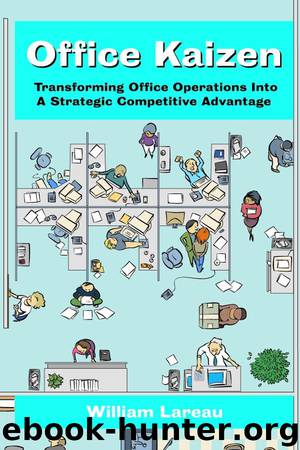Office Kaizen: Transforming Office Operations into a Strategic Competitive Advantage by William Lareau

Author:William Lareau [Lareau, William]
Language: eng
Format: azw3
ISBN: 0873895568
Publisher: ASQ Quality Press
Published: 2002-06-12T04:00:00+00:00
It is essential to focus the group’s generation of ideas on low-tech solutions that they can do themselves. It is too easy for most work groups to blame their problems on lack of software, technology, money, or personnel. The entire purpose of the LDMS (and Office Kaizen) is to attain a competitive advantage from the massed effects of thousands of small, low-tech sources. This means that in the above example, the list of code numbers would be put on a piece of paper, copied, and then placed at each desk, perhaps in a plastic, protective sleeve. It would not be submitted as a software request to have the code numbers put into a pop-up menu on each person’s computer screen. This might be the appropriate downstream action in a year or two, but it is a disastrous short-term solution. A computer support request would take months to process, be costly, require dozens of hours of support from the intact work group, and encourage the intact work group to depend upon others to make its work better. Even worse, the idea may not work. Over a few months to a year, the work group tests and optimizes the solution. If a site-wide coding system is needed, it should come from the ESC, not a work group (every work group is, of course, free to forward ideas to the ESC through supervisors, managers, champions, and mentors).
Once a KAS is completed or found to be impractical, it is moved to the “resolved” folder. Do not permit anyone to computerize a list of the KAS. If a list is computerized, it will not be long before site management and then corporate management requires status reports on KAS “productivity.” Massive amounts of time and resources will be wasted. Do not collect them, list them, or send them to other sites as “lessons learned” or best practices. The “best practice” that should be promulgated is installation of the LDMS and the KAS system. Each intact work group at other sites has plenty of its own ideas that will surface within its own KAS system.
There is a tendency, when the KAS system is first installed in a traditional work group, for employees to generate considerable numbers of ideas that require information system support and/or the purchase of equipment. It is imperative that every work group be told that there will be no large expenditures or extensive systems work done in a work group until that intact work group attains 50 points on the KCG 20 Keys (which will be described in chapter 9). This will compel each intact work group to explore low-tech solutions (thus taking control of their destiny with actions they can control). By the time a work group attains 50 points, most of the big expenditures it would have suggested earlier will not be necessary or desired. The only exception to this guideline, of course, would be safety or customer quality issues. Critical, large expenditures and/or requests for extensive systems support can always originate from change teams reporting to the executive steering committee.
Download
This site does not store any files on its server. We only index and link to content provided by other sites. Please contact the content providers to delete copyright contents if any and email us, we'll remove relevant links or contents immediately.
Bad Blood by John Carreyrou(6274)
Rich Dad Poor Dad by Robert T. Kiyosaki(6174)
Principles: Life and Work by Ray Dalio(5957)
Playing to Win_ How Strategy Really Works by A.G. Lafley & Roger L. Martin(5495)
Management Strategies for the Cloud Revolution: How Cloud Computing Is Transforming Business and Why You Can't Afford to Be Left Behind by Charles Babcock(4438)
The Confidence Code by Katty Kay(4036)
Thinking in Bets by Annie Duke(3996)
American Kingpin by Nick Bilton(3507)
Delivering Happiness by Tony Hsieh(3280)
Project Animal Farm: An Accidental Journey into the Secret World of Farming and the Truth About Our Food by Sonia Faruqi(3016)
The Power of Habit by Charles Duhigg(2965)
Brotopia by Emily Chang(2892)
Mastering Bitcoin: Programming the Open Blockchain by Andreas M. Antonopoulos(2891)
The Tyranny of Metrics by Jerry Z. Muller(2846)
I Live in the Future & Here's How It Works by Nick Bilton(2844)
The Marketing Plan Handbook: Develop Big-Picture Marketing Plans for Pennies on the Dollar by Robert W. Bly(2792)
The Content Trap by Bharat Anand(2778)
Building a StoryBrand by Donald Miller(2754)
Applied Empathy by Michael Ventura(2749)
